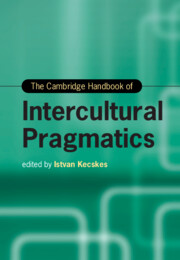Book contents
- The Cambridge Handbook of Intercultural Pragmatics
- Cambridge Handbooks in Language and Linguistics
- The Cambridge Handbook of Intercultural Pragmatics
- Copyright page
- Contents
- Figures
- Tables
- Acknowledgment
- Contributors
- Introduction The Rise of Intercultural Pragmatics
- Part I Theoretical Foundation
- 1 Post-Gricean Pragmatics for Intercultural Communication
- 2 Relevance Theory and Intercultural Communication
- 3 Cognitive Psychology in Pragmatics
- 4 The Theoretical Framework of Intercultural Pragmatics
- Part II Key Issues in Intercultural Pragmatics Research
- Part III Interface of Intercultural Pragmatics and Related Disciplines
- Part IV Intercultural Pragmatics in Different Types of Communication
- Part V Language Learning
- Index
- References
1 - Post-Gricean Pragmatics for Intercultural Communication
from Part I - Theoretical Foundation
Published online by Cambridge University Press: 29 September 2022
- The Cambridge Handbook of Intercultural Pragmatics
- Cambridge Handbooks in Language and Linguistics
- The Cambridge Handbook of Intercultural Pragmatics
- Copyright page
- Contents
- Figures
- Tables
- Acknowledgment
- Contributors
- Introduction The Rise of Intercultural Pragmatics
- Part I Theoretical Foundation
- 1 Post-Gricean Pragmatics for Intercultural Communication
- 2 Relevance Theory and Intercultural Communication
- 3 Cognitive Psychology in Pragmatics
- 4 The Theoretical Framework of Intercultural Pragmatics
- Part II Key Issues in Intercultural Pragmatics Research
- Part III Interface of Intercultural Pragmatics and Related Disciplines
- Part IV Intercultural Pragmatics in Different Types of Communication
- Part V Language Learning
- Index
- References
Summary
The chapter addresses the relation between post-Gricean pragmatics and intercultural pragmatics. As such, it addresses meaning in relation to intentions and inferences and provides an overview of the main developments in this tradition, placing them in the context of the utility they have for understanding cross-cultural communication, and specifically the acquisition of pragmatic competence. Section 1.2 introduces the concept of pragmatic universals and moves to discussing how Grice’s account of cooperative conversational behavior can be viewed as such pragmatic universal principles. After pointing out some problems with Grice’s original account as it is seen from the perspective of several decades, Section 1.3 proceeds to post-Gricean approaches to linguistic communication, focusing not so much on the traditional debates concerning the number and scope of the necessary maxims or principles (covered briefly in Section 1.3.1) but rather on the semantics/pragmatic boundary and the related question of the truth-conditional content that opened up interesting contextualist pursuits (Section 1.3.2). Section 1.4 addresses different versions of contextualism and places them in the context of the debates between minimalists and contextualists. Section 1.5 concludes with comments on the utility of post-Gricean pragmatics for intercultural communication, stressing the significance of pragmatic universals.
Keywords
- Type
- Chapter
- Information
- The Cambridge Handbook of Intercultural Pragmatics , pp. 11 - 39Publisher: Cambridge University PressPrint publication year: 2022
References
- 1
- Cited by



